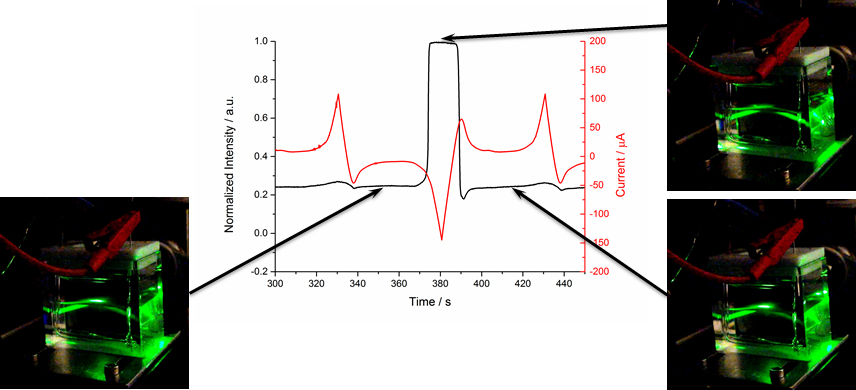Electrovariable Nanoplasmonics at Liquid-Liquid Interfaces: the Case of Marangoni Shutters
Ongoing climate change requires enormous amount of energy rather to cool our building then to warm them up. Thus, smart systems capable to switch between “mirroring” and “transparent” states on demand can significantly reduce the energy costs. In this case, nanoplasmonic devices are of high practical importance due to tunable adsorption and reflectance. In its turn, a liquid-liquid interface (LLI) represents almost an ideal platform to realize such devices due to surface energetic homogeneity, flexibility, self-healing nature, and possibility to control nanoparticles position by an external electric field (the case of two immiscible electrolytes solutions, ITIES).
Previously, the research in the field was focused on “vertical” landing of nanoparticles from the bulk of one phase to ITIES in order to form mirror-type films.[1,2] However, this approach has two major restriction limiting practical applications: slow diffusion and low concentration of the nanoparticles. In contrast, we propose here to use “horizontal” or in-plane movements of nanoparticles driven by changes in interfacial tension. The latter is caused by interfacial transfer of surfactant molecules (SDS) upon applying of the external electric field. We called such systems “Marangoni-type shutters”. In fact, the Marangoni effect (the mass transfer along an interface between two fluids) has been used previously to power movements of capsules at LLI.[3]
We observed that Marangoni effect induces migration of citrate covered gold nanoparticles located close to the ITIES from the middle region of the cell to its periphery with polarizing of the ITIES.[4] In this work we showed that moving of nanoparticles in-plane of the interface can be performed repeatedly (up to 20 cycles) with significant change of the reflectivity (Fig. 1). This type of electrovariable nanoplasmonic device does not have diffusion limitation and the entire movement of nanoparticles assemblies happened almost instantly (within a second). The present approach opens a fresh view on electrovariable nanoplasmonics and proposes new opportunities to create smart nanosystems at ITIES driven with electric field.

Fig. 1. Marangoni shutter in action: cyclic voltammogram and corresponding reflection of the film.
[1] M.E. Flatté, A.A. Kornyshev, M. Urbakh, J. Phys. Condens. Matter., 2008, 20, 73102-73110.
[2] M.E. Flatte, A.A. Kornyshev, M. Urbakh, J. Phys. Chem. C., 2010, 114, 1735–1747.
[3] G. Zhao, M. Pumera, J. Phys. Chem. B., 2012, 116, 10960–10963.
[4] G.C. Gschwend, E. Smirnov, P. Peljo, H. Girault, Faraday Discuss., 2016, in press.